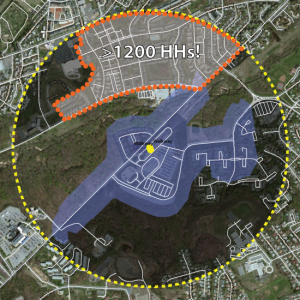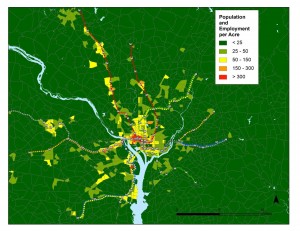Prioritizing Bike and Pedestrian Station Access Projects Near Metrorail
We all know improving station access is good. But, how do we rank access projects relative to each other? Step 1: Ridership
In our recent post, we gave you an overview of our Station Access Investment Strategy project. We’ve identified 1,000s of recommendations for new pedestrian and bicycle infrastructure near our Metrorail stations and need a way to prioritize them. After some thought, we’ve come up with a number of potential criteria. In this post, we’ll discuss those that deal with ridership.

Map of the Southern Ave walk shed from July 2014 Post on Ridership Potential from New Ped./ Bike Projects
Once again, one of key concepts we’ve been telling you about in recent months is that by improving access to stations we can grow ridership. For stations with relatively small walk sheds, we’ll conduct a detailed analysis of what happens to the walk shed when the proposed projects are built. For example, add a sidewalk at Cheverly and the walk shed will grow by X%. We will then look at the amount of households and jobs in the newly connected area and, using some methods we’ve shown you in other posts, calculate the potential ridership gained by the new project. The higher the potential ridership gain, the better the project scores.
But, we also want to understand the value of a new project to a part of the station that is already connected to the network and how this could relate back to ridership. To do this, we’ve come up some other metrics. They include:
- Population and Employment Density: Projects that serve areas with higher density of jobs or housing will score better than projects that don’t.
- Low Existing Walk/ or Bike Mode of Access: Projects in station areas that currently have a low percentage of walk and bike access relative to other modes will score better. The idea being that there is latent demand in these locations: improve the infrastructure and they will come.
- Walkscore: We know transit riders tend to “trip-chain,” stopping off on the way home from work at the dry cleaner or to pick-up dinner. Projects in areas with a high walk score should score a little higher since they may help lead to more transit use.
We’ve begun to lay out a way to score each project using these criteria. What other ridership-oriented criteria can you think of to help us rank bike/ped station access improvements? In the next post, we’ll discuss with you some other criteria that we will use in prioritization.



Recent Comments